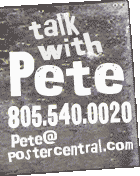
 |
||||||
| Hank Williams poster after restoration | ||||||
| Hank Williams poster before restoration |
Poster Collector's Blog Most poster collectors have been there before: You buy a vintage poster that you love, but it’s pretty beat-up. Or you’re thinking of getting an old poster, but it’s torn and tattered. Do you go to the time, trouble and expense to have it professionally restored? In most areas of poster collecting – from psychedelic art-rock to the movie-poster world – the general consensus is, “Yes,” if the economics allow. Everyone wants their poster to be as pristine as possible, as close to the day it was printed as one can get. After all, the better the condition, the more a poster is worth – never mind the aesthetics. But the cardboard concert-poster world – comprised of “boxing-style” posters covered in depth on this site – sees things a little differently. Many collectors are just not in a hurry to restore this type of poster. Perhaps it’s the lack of fancy artwork or graphics, which require looking good. Maybe it’s the fragility of light, thin, paper posters which makes them seem vulnerable, whereas thick cardboard posters are perceived as “hardy” and not as needy for help. Whatever the reason, many cardboard collectors just don’t want to pull the restoration trigger. But his point is well-made: boxing-style collectors don’t care nearly as much about damage or aging. One of the most common phrases you’ll see in ads from people hunting for these posters - including myself - is “Condition not important.” We don’t mind at all if our posters look old, feel old, even smell old… it only makes them feel more genuine as a timepiece from a bygone era. The paradox is that if you were to discover two copies of the same old poster side-by-side, one in near mint condition and the other in VG, there’s no question that virtually everyone would want the better copy. It’s human nature, and there’s the value thing. If half of the color and ink is faded away, it can really zap the life out of a piece. And when part of the poster is missing at the malicious hands of a previous owner, collectors will often pass and just wait it out for another one. “Trimming and fading are the kiss of death,” veteran dealer Andrew Hawley tells postercentral.com. “Those are the worst things to [encounter].” But like all the other flaws stated above, there are restoration experts who can restore faded information and missing borders. I’ve actually been confronted with quite a restoration dilemma myself over the last few years. I was lucky enough to discover a rare, original poster for the legendary concert that Hank Williams died en route to – New Year’s Day 1953, Canton, Ohio. It’s a large, beautiful poster with every element you could ask for – big size, bright colors, a picture of the artist, song titles, opening acts, detailed ticket information, etc. I acquired it back in the early 1990s, and eventually traded it away. The new owner had it lovingly restored, so it looks pretty clean and intact now (see picture). I was lucky enough to acquire a second one in the late ’90s, which was more beat-up, with a very pronounced water stain. But unlike the other guy, thus far I’ve chosen not to restore it in any way. I’ve decided that I simply love the way it looks, like it was just torn off the side of a barn in January 1953. Rips, tears, water stains, writing… ah, the writing. Above Hank’s name somebody scrawled in pencil, “Hank died in rear car seat on way to do this show… The show Hank dident [sic] make.” Was it written that very same day, on January 1st after Hank was found dead? Or inthe ensuing days? Or even a year or two later? It’s a little mystery that will never be solved, and adds an element of intrigue to the poster. And yet, I’m torn because I can’t deny the beauty of an original poster that’s had a facelift and still retains all of its original elements. It may sound indecisive, but I swear, to this day I don’t know which of the two Hank Williams concert posters I’d rather have. But before you say, “Ah, come on, how can you even debate it?”, can’t it be argued that my poster is 100% original while the restored version is only 95-98% original? (With bits of 21st-century cardboard, ink, etc. added to it.) My Hank Williams poster also hung in the Cartier Foundation’s The Genesis of Rock & Roll in America 1939-1959 exhibit in Paris, France this summer. I proudly attended the grand opening in June (2007), and gazed at my artifact hanging high on the wall. I was struck by the sharp contrast between the gorgeous, modern, steel-and-glass Cartier Exhibition Hall and my little 2 by 2.5-foot patch of dirty, hillbilly authenticity which hung therein. I'd be curious to hear from readers: Would you clean up this poster if you owned it, or let it ride exactly as it was found 54 years ago? Send me an e-mail by clicking on the link below, and I'll share them with our readers, unless you request privacy. Thanks for stopping in, Pete Howard • pete@postercentral.com | Respond To This Blog | Reader Responses |
|